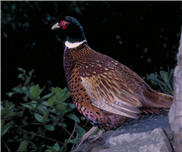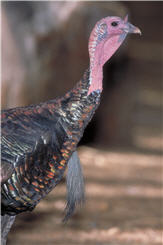 Ring-necked
Pheasant
Phasianus colchicus
Ring-necked
Pheasant
Phasianus colchicus
A
native of Asia, the Ring-necked Pheasant
has been introduced widely in North America as a game bird. It
thrives best in grain-growing regions, which no longer include San Diego County. The pheasant’s status
in the county is tenuous; the birds may not be breeding in the wild and
are seen with any consistency at only two sites. For hunting, the
California Department of Fish and Game currently releases only males at
Rancho Jamul and San Felipe Valley, guarding against the possibility of
a feral population’s establishing itself from that source. Escapees
or releasees from private breeders are also seen occasionally.
Breeding/winter
distribution:
From 1997 to 2002, the Ring-necked Pheasant was seen most regularly in
and near Guajome Regional Park (G7), with up
to five near the junction of Melrose Drive and Bobier
Drive 10 and 12 April 2001 (C. Andregg) and
ten in Guajome Park 23 December 2000 (C. G. Edwards). Another
site was in north Escondido near Jesmond Dene Park and in the surrounding
valley (H10), where Dan and Debi Bylin
noted one or two individuals regularly, including a male and female together
8
April 1999,
our closest suggestion of pheasants breeding
in the wild in San Diego County. Also, a male found
struck by a car here 16 March 1998 had enlarged testes (SDNHM
50023). Three observations between De Luz and Fallbrook (C6/C7/C8;
K. L. Weaver) may mean a small population persists in that area.
Six sightings of up to two individuals from Wynola
(J19) to Pine Hills (K19) were likely the result of releases by, or escapes
from, exotic pheasant breeders in Wynola (S.
E. Smith).
On a few occasions we saw the birds released for hunting at Rancho Jamul
(S15) and San Felipe Valley (I21) and noted their dispersal as far as
Dulzura (U17; one on 30 January
2001,
D. Povey) and Sentenac
Ciénaga (J23, one on 10 April 1999, D. Tomlinson). The
few scattered sightings elsewhere were all likely of escaped captives.
Conservation: No history of the Ring-necked
Pheasant’s introduction into San Diego County has been preserved, and,
until the beginning of the releases at Rancho Jamul and San Felipe Valley
in the late 1990s, may have been done by private individuals or clubs
only. The earliest published records are from Christmas bird counts,
on the Oceanside count beginning in 1952
and on the San Diego count beginning in 1955.
The species was never more than uncommon and local and declined as urban
sprawl spread over the pastureland and agricultural land where it was
formerly seen. The number reported on the Oceanside Christmas bird
count peaked at 18 in 1963. On the San Diego count, the pheasant was
last reported in 1968, on the Escondido count in 1989, and on
the Rancho Santa Fe count in 1990. The introduction of the Ring-necked
Pheasant into San Diego County appears to be on the verge
of failure early in the 21st century. The current release
program consists of “put and take” rather than an introduction intending
to establish a self-sustaining population.
 Wild
Turkey Meleagris
gallopavo
Wild
Turkey Meleagris
gallopavo
Though
native to North
America,
the Wild Turkey is not native to California. Early efforts to
introduce the species to San Diego County failed, then in 1993 another attempt took root. By 2002 the birds
had spread from two points of release in central San Diego County north to the Riverside County line and south to within
ten miles of the Mexican border. The name “Wild” Turkey is a misnomer
as far as San Diego County is concerned; far from remaining in wild areas
where they would offer real sport to hunters, the birds accumulate in
parks and around human settlements where they can’t be hunted—domesticating
themselves.
Breeding
distribution:
From January to March 1993, the California Department of Fish and Game
released 234 turkeys on private ranches near Sutherland Lake (J18) and
at Pine Hills (K19). From these sites, the birds spread over most
of the oak woodland of central San Diego County. They had begun nesting
by 1997 and probably earlier. By 1999 the county population was
estimated at 1500. During the breeding season our counts ran as
high as 25 in La Jolla Indian Reservation (F15) 17 May 2000 (S. Berg),
25 in Cañada Verde, Los Coyotes Indian Reservation (F20), 12 May
2001 (D. W. Au, K. J. Winter), 25 in the Edwards Ranch northeast of Santa
Ysabel (I19) 16 March 2001 (D. W. Au), and 30 north of Julian
(J20) 26 June 2001 (O. Carter). Most of the birds have remained
in the mountains and foothills, but a few have spread down to the coastal
lowland, where noted west to Wilderness Gardens (D11; one on 6 April and
18 May 2000 (V. Dineen), Escondido (J11; up
to two on 27 June 1998, W. Pray), and upper San Clemente
Canyon, Air Station Miramar (O11; one on 18 May 2000, G. L. Rogers).
During the atlas period turkeys spread east toward the desert as far as
Scissors Crossing (J22; one on 17 March 2001, R. Thériault),
and afterward even farther, far outside suitable habitat: up to 11 at
the north end of the Borrego Valley (E24) 13 May 2002, four in the Ram’s
Hill development of Borrego Springs (H25) 7 April 2002, and two at Tamarisk
Grove (I24) 4–11 April 2002 (M. C. Jorgensen, P. D. Jorgensen).
Nesting: Turkeys nest in a scrape on the
ground. Our two dates of nests with eggs are 26 April and 5 May.
On the latter date, the incubating hen was found killed by a bobcat, as
attested by tracks around the nest (R. Botta).
Our observations of turkey chicks, however, show the species has a long
breeding season in San Diego County. The earliest date
for chicks, 22 March 1998 in upper San Felipe Valley
(H20; A. P. and T. E. Keenan), means that incubation of the clutch began
by 22 February in this wet year. Otherwise our earliest date for
chicks is 17 April 1999. Several records
of chicks extend into August; the latest was of young only one quarter
grown near Descanso (P20) 27
August 1998
(D. W. Povey).
Migration: The turkey is nonmigratory but capable of dispersing considerable distances
over a short time, as the birds’ spread demonstrates. One bird fitted
with a radio transmitter and released near Sutherland Lake moved 12 miles north, as
far as the west fork of the San Luis Rey River
(R. Botta).
Winter: We encountered turkeys
in winter in even larger flocks than during the breeding season, up to
75 in the Edwards Ranch 8 January 2000 (D. W. Au).
Conservation: The turkey was first introduced
into San Diego County on Palomar Mountain in 1931, but that attempt,
using domestic birds from a game farm, failed. Another introduction,
in 1959 of 57 turkeys from the King Ranch, southern Texas, released at Corte Madera
Ranch, resulted in numbers estimated at 200–300 by 1965. After San
Diego County’s biggest recorded fire, the Laguna fire of October 1970,
the population was much reduced, never recovered, and apparently died
out by 1985 (Calif. Dept. Fish and Game 1995). Releases in Camp Pendleton in 1978 and on Palomar Mountain in 1990 were likewise unsuccessful.
The more ambitious introduction in 1993 was controversial
from the beginning, promoted by hunting interests, opposed by the California
Native Plant Society, Save our Forests and Ranchlands, California State Parks, and some private
landowners. A lawsuit brought by the first two organizations blocked
further releases beyond those in 1993, but the initial introduction proved
sufficient to populate much of the county. Much of the better turkey
habitat, oak woodland with broken shrubby understory,
is on private property and in Cuyamaca Rancho State Park where hunting is prohibited.
Comparatively little is in the chaparral-dominated lands of the Cleveland National Forest, where hunting is permitted.
On one of our field trips to cover north-central San Diego County, 1
May 1999,
we encountered turkey hunters searching in vain for the birds in Blue
Canyon (E17), within the national forest. The same day, we encountered
the turkeys themselves just 2 miles away at Puerta
La Cruz Conservation Camp (E18), where they walk around the prison grounds
with no regard for people. Concern has been expressed over the turkeys’
possibly depleting the food supply (especially acorns) on which native
wildlife relies, their preying on rare reptiles and amphibians, and over
their possibly degrading the habitat of certain rare plants. California state parks have as their
goal conserving native wildlife and preventing the spread of exotic organisms,
so the California Department of Fish and Game, at the instigation of park
authorities, has trapped and removed over 160 turkeys from Cuyamaca Rancho State Park since 1995. The park
had become one of the sites of greatest turkey concentration in San Diego County, but in spite of the trapping
the numbers both inside and outside the park continue to increase.
Similarly, the U.S. Forest Service expressed concern over the likelihood
that the turkeys would spread into designated wilderness areas, where
introductions of nonnative plants and animals are forbidden.
One argument in the debate was that the turkey is not a truly exotic species
in California because it is known here
from Pleistocene fossil remains. The fossil species, Meleagris
anza Howard, 1963,
and M. californica (Miller, 1909), however,
are not the same as the extant M. gallopavo.
Meleagris anza,
found in the Carrizo Badlands, dates from the early Pleistocene when the
environment was far different from today’s.
Taxonomy: The turkeys released in
San Diego County in 1993, of intermediates
between M. p. intermedia Sennett, 1879, and M. p. gallopavo
Vieillot, 1817, were trapped in the wild in
eastern Texas (J. Massie, California
Department of Fish and Game).
 Ring-necked
Pheasant
Phasianus colchicus
Ring-necked
Pheasant
Phasianus colchicus Wild
Wild